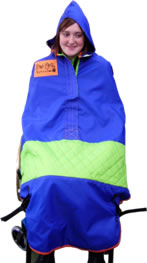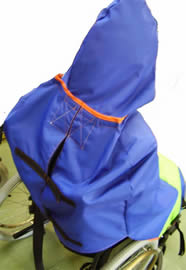Wet-weather wheelchair garment
 Bonnie Hasson
Bonnie Hasson
Queen Margaret College
Year 13 Materials Technology, full-year project
Teacher: Barbara Knight
Bonnie was interested in a project that would have a 'helping the community' focus. After brainstorming different contexts she decided to consult the nearby Kimi Ora School, which serves teenage students who have special needs, such as high-level physical disabilities.
Bonnie discussed a range of different needs with deputy principal Christine Jones - things that could be improved to help make everyday activities a little easier for the staff and students. After researching various issues, Bonnie proposed to develop an improved design for the school's existing wet-weather wheelchair garment.
The existing garment had several weaknesses: its drab brown colour did not appeal to teenagers, its shape and length meant it got caught in the wheels of the wheelchairs, it was difficult to put on, and the students felt it was restrictive on the wearer. Kimi Ora also wanted the new cover to include an 'upbeat' version of the school's logo for identification when on outings.
Brief
Redesign the existing wet-weather wheelchair cover for teenage students to wear at Kimi Ora School. The design should be fun, functional and represent what Kimi Ora School is all about - good health /life.
Specifications:
- Comfortable to wear
- Easy to out on and take off
- Easy to use fastenings - Velcro was specified as a preference
- Not get caught in the wheels of the wheelchair
- Waterproof
- Colourful and appealing to teenagers
- Include an upbeat identification school logo
Teacher comment
It was important to research existing wet-weather wheelchair items. Bonnie contacted several wheelchair manufacturers to find out if there were any laws or regulations to adhere to. It turned out the most important design factor was common-sense - that the garment should not get caught in the wheels when in motion.
A pattern was drafted from the existing wet-weather garment and models were made to find out what exactly were the weaknesses of the original item. Bonnie hired a wheelchair for a couple of weeks to help test the design models at school. Getting a feel for wearing the garment while in a wheelchair was valuable as it quickly pointed out the aspects of the pattern that needed to be modified for better functionality.
Fabrics and colours were selected and approved by Kimi Ora students and the new design concept was approved by the staff at the school. Different fastening techniques were trialled for potential failure points until the final design was resolved. The final garment included brightly coloured, fun fabrics, easy-to-use fastenings, a detachable hood for versatility, and a quilted knee panel for warmth and weight (to prevent it blowing up in Wellington's wild winds).
Bonnie developed empathy during the project. She had to think closely about the needs of others and find out what it really means to have limited mobility. She learnt everyday activities have their own special requirements that must be

Bonnie produced a good-looking and functional design. Pleated vents at the back and adjustable straps across the back and at the wheelchair posts allow the cover to fit different sized teenagers. A detachable hood makes the cover able to be used in windy / not just rainy weather.
Related links: Te Papa Souvenirs case study






